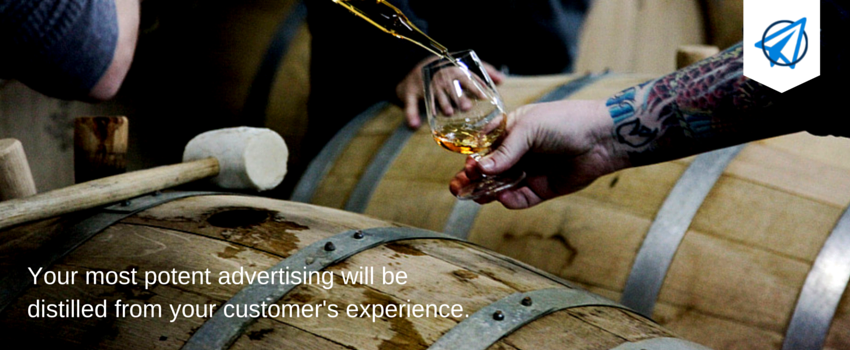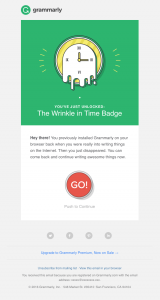How are people supposed to pick your ads out of the crowd? As a small business owner, how do you create marketing that is potent and persuasive without breaking the bank?
From advertisements alone, your target market is exposed to thousands of messages every day. Putting a number to it is difficult. Researchers have said anywhere from 100 to 5000 ads per day. When you think about it, almost everywhere we go, physically or digitally, there is advertising.
Corporations have entire departments with seasoned professionals devoted to winning your attention. They employ research and data firms to find out as much about you as possible. Then they spend thousands, even millions on buying ad space in all the places they think you’ll be.
For this reason many small business owners back away from marketing and rely solely on referrals. But your marketing can be potent without investing all of your profit into media buying.
As a small business, you have the distinct advantage in customer interaction. Even if you run a small software developent firm that deals with enterprise clients, the distance between you and the client is much easier to cross. Executives of major corporations, the people responsible for the direction and attitude of the company, are leagues away from their clients.
All their research and development cannot replace the intimate nature of your small business. Getting to know your customer is a simple process. Defining their pain points, hopes, and desires is a personal (and therefore more powerful) affair.
You have seen their expressions and body language as they describe their frustrations to you. You have the uncomfortable experience of witnessing their displeasure. You know the elation that comes from a customer’s relief and gratitude for solving their problem.
Advertising wins when it matters to the target market. And you have personally witnessed what matters to your customers.
However, crafting those experiences into advertising is another matter. Distilling pain into words isn’t always easy. The relief of a problem solved can be hard to express.
That’s why you use your customer’s very own words. Use testimonials, customer stories, and case studies to prove you can deliver the experience people are hoping for. Your experience is important too. Tell the story of your product’s development and your company’s history.
These tools will help you distill an experience into high test marketing. Let’s take a look at how to use each tool properly, like finding the right ingredients to be distilled into smooth, strong whiskey. Then we’ll look at how to apply heat to these ingredients to get exactly the right experience.
Testimonials – Find the moment of truth.
Collect customer feedback religiously. Ask them the hard questions (what they didn’t like about their experience) and ask them to elaborate on the easy questions (what they loved about their experience). Find out if there was anything else they were hoping for. From that feedback you should be able to construct amazing advertising.
Specifically, a testimonial is when the customer praises the experience they had with you and your business. When extracting a testimonial from customer feedback, find the moment of truth. That moment when they personally discovered that you and your product were the real deal.
What you’re looking for and what you want to actually use in advertising is:
- How they say “thank-you.”
- How they felt when they saw the results for the first time.
- How this experience has affected their near future (how they plan to continue with your brand).
- How has this experience affected them personally? How has it affected the people closest to them?
Grab the positive, emotional language they use and reproduce it in your advertising verbatim. Edit testimonials for clarity, but that’s it. Keep the original language as much as possible.
How long should a testimonial be?
Determining the length of a testimonial can be tricky. It’s all about where the testimonial shows up. Limited ad space obviously means a shorter testimonial. Longer mediums such as: sales letters, some social posts, videos, landing pages, product pages, catalogues and brochures can accommodate longer testimonials.
Where do testimonials go?
Place the shorter testimonials closer to the top of the page or above the fold of a web page. Use the shorter testimonials as teasers and quick intros to the opportunities with your brand. As you unpack the benefits of your product, use longer testimonials to prove each benefit.
You will notice that many people put all their testimonials in one spot on long form advertising. That works because often shoppers or potential clients will search for these sections to see what real people are saying about you and your product. However, make sure you’re still scattering testimonials through out the ad.
Don’t be afraid of using a lot of testimonials. Just make sure you’re placing them in the best places. Everything we are talking about here is “social proof.” Other people are backing you up, testifying in the court of public opinion that the reader won’t regret doing business with you. So use this proof in areas where the strongest objections will arise. Be logical. A testimonial praising your customer service ability should be found with your customer service guarantee, not with your price announcement.
Customer Stories – Reveal the heroes.
Some of your customers found you in peculiar ways, under bizarre circumstances. Collecting feedback will make it easier to identify these unique customers. Get in contact with them and ask them if you can feature their story. Not everyone wants that kind of attention, but most of the time people love to share their story
This is different from a testimonial because it’s a person’s full story, not just praise for a product. Long testimonials run into this territory, but they are used to power a larger advertisement. Customer stories are the advertisement. If you mention a product or offer at all, it’s at the end and takes up 5% of the ad. Your first concern is to establish credibility through this story. Then you can offer something.
To keep the story authentic and to make it easier on yourself, keep the customer as the hero and the narrator. When you ask them for their story, ask questions in a way that makes it easy to turn it into a story. You should be able to copy and paste the answers into a document in the order you asked them and have the story perfectly compiled. Look for unique stories to showcase, but use the common accounts as well. Give people a sense for what’s typical and an idea of what’s possible.
Where do you put customer stories?
The story is the advertisement, unlike a testimonial that is only a piece of an advertisement. Stories can be used in ways that ads cannot. They can be told through video, over social media, in news articles, podcasts, and blog posts as their own entity. Place them in front of people who are looking for information. When your ideal customer goes looking for a solution to their problem, you don’t always want them to find your ads first. Sometimes they need a good first impression, something that will build your credibility with them. Customer stories are an excellent, personal, real life way to show searchers that you can deliver what they are hoping for.
Practically, make your customers’ stories easy to access. We research online first now, so meet people online. Have videos, blog posts, or podcasts openly visible on your website, featuring all your customer stories. Put any videos on Youtube as well, podcasts on iTunes and written articles on your blog. Write for other blogs that serve a similar audience. Having an easily accessible online presence is a strong foundation. Then you can publish stories in news papers, magazines, or other traditional media outlets.
What should a customer story look like?
Your customer is the hero of their story. Tell the whole saga from discovery to loyalty. Ask these questions and you should be able to quickly convert the answers into a story without much editing.
- What was the problem you faced? Can you tell me how the problem developed?
- How did you discover our company (product/service)?
- What convinced you that we could best meet your needs?
- Then you used [the product]. What was that first experience like and what did you think of the results?
- How has that experience continued or evolved?
Another factor to look out for is who is using your product. Is there a well known, influencial person that has enjoyed your product? Tell their story. If they have a fan base, customer base, or any kind of audience, sharing their story exposes your brand to them as well. Also, celebrity endorsement throws the weight of their approval behind your name.
Product / Company Background Story – Why did it all start?
Your own discovery process can be exciting as well. Most entrepreneurs have a eureka moment when they discovered that they held the solution to a problem someone faced. Telling the story of that discovery process. Describe the struggles you went through while developing the product and how you overcame each struggle. But through it all, keep the customer the hero of the story. Remember the reason why you created the product in the first place: to solve your customer’s problem.
Each struggle that you overcame while developing your product should be framed as a success because you found a way to further serve your customer.
Try to remember the passion you had as you launched your business. For some, that may be hard, for others, that passion is still there. Ask your self “why?” at each stage of development. Capture the emotion of each experience.
The technical details can be valuable to a knowledgeable audience as well. Is yours a hands-on process or is it automated? Are their formulas involved? Describing these, without divulging company secrets, can help convince the practical shoppers that you offer a quality product.
Case Studies – Stories by the numbers.
Case studies are exceptionally useful in business-to-business relationships. Study the real-life success of one of your clients. Get permission to report the numbers to the public. This allows you to not only tell a story, but give statistical proof of your product’s ability.
The way some companies create a case study is extremely dry and boring. Keep the emotion and personal connection of a customer story, but add measurements as much as possible. If you have the privilege, take measurements before and after use of your product.
The key is to find out what your client is hoping for and then measure the results to prove that their hopes were met or exceeded.
Case studies make great resources to hand out for free as lead magnets. But they can also inspire many other pieces of content. Create shorter videos, podcasts, infographics or blog posts that give readers a glimpse of the case study. For example, only describe your product’s impact on one department or one market segment. Leave the full results out as a teaser so the reader wants to access the full study.
To keep it simple, break down each case study into stages: Struggle, Goals, Application and Results.
Struggle
Describe your client’s struggle. What problem are they hoping to solve? What is their current condition?
Goals
What exactly are your client’s expectations? What results are they hoping for? Describe these hopes as emotional benefits, but set numbers too. Make it scientific.
Application
How does your product fit into your clients life? What does a day of use look like? Describe any learning curve they had to navigate as well. It’s all a part of the experience.
Results
What were the results, emotionally and numerically? Were their hopes fulfilled?
Create Tension. Bring the Heat.
When distilling any liquor, you need heat. Use tension to bring the heat. In all of your stories and testimonials, make sure there is stark contrast between the problem and the solution. Don’t be concerned if the struggle seems a little overbearing. Just be sure that the solution provides exactly the relief the reader was hoping for. Because you’re using real stories from customers who have felt this relief, that shouldn’t be too hard.
Here are some other tips to create tension in your marketing:
- Be vivid. You don’t have to write like Tolkien, but don’t omit details because you think they may seem too dramatic.
- Ask hard questions. I mean questions you may not want to hear the answer to. If the answer could potentially damage your credibility, it adds to the authenticity of the story. Publishing a damaging admission is actually an effective and common practice.
- Hint at it, but don’t give away the results too quickly. Take your time to explain circumstances and build hope for a certain outcome.
Conclusion
As a small business owner, you don’t always have time to craft high converting ads. And you don’t necessarily have the resources for in-depth market research and data mining. But it costs very little to print out a feedback form. Some of your most potent advertising will be distilled from their experiences.
(Photo courtesy of Matthew C. Wright.)
Business & Finance Articles on Business 2 Community
(202)









